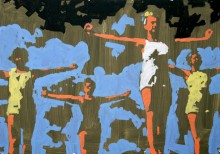The Sport project reveals the essence of art through images of competitions, soccer players, runners, etc. “Art and sport have arena in common. Also, art, as well as sport, needs the spectator,” the gallery’s owner and curator of the exhibition Oleksandr Shchelushchenko explained his idea. “Each artist is an athlete who wants to prove to the world that their visual experience is the best and most valuable.” The exhibition presents works by artists who have long cooperated with the gallery: Mykola Bilous, VALYA, Yaroslav Derkach, Rustam Mirzoiev, Serhii Oleksiuk, and Yevhen Petrov.
The exhibition’s centerpiece is a podium, looking just as ones used to present awards to winners at sports events, but inscribed with numbers 4, 5, and 6. This podium has been created by Derkach, a native of Luhansk. “This work is an ode to the runners-up,” Shchelushchenko commented. “In sport, few people know about those who take fourth and fifth places, but there are a lot of them, and they are talented people who sacrificed it all to win the championship. In art, a similar situation is even clearer. Every artist is either the first in their craft or nobody. Thus, Derkach’s work tells a story about the fine line between winners and runners-up, and honors which are assigned by the position, which, too, is basically an abstract concept.”
Odesite Petrov’s watercolor is astoundingly close to a photo. His painting Where to Run? depicts a group of athletes rushing along a beach, dirtied with black mud. No one knows where to run, but they have to, and moreover, each must be the first to cross the finish line. By analogy with athletes, artists, too, chase indescribable targets. Small sculptures by Petrov stand nearby, showing athletes as they are as well. A shorts-clad man lifts dumbbells, another drops a bar, while amateur soccer players chase the ball in the mud. Through these images, the artist destroys the pathos of competition and life in general.
Paintings of sports parade and cheerful amateur women athletes are full of lush patches. Their creator Bilous combines colors using his own unique technique. Shchelushchenko told us about Bilous’s works: “Against a khaki-like background, he paints with a color which is a mixture of the three primary colors of red, blue, and yellow. When covered with any contrast paint, it is harmonized. The technique requires that the artist put color in one layer, very gently, and then the mixture becomes semi-transparent and extinguishes the contrast.” Bilous also paints air black, so it looks theatrically: while the background is dark, the foreground seems to be flush with spotlights.
VALYA’s work A Pleasant Surprise. Lyndyk is a spicy interactive piece. A huge linen rope hangs lowered from the gallery’s ceiling to the floor, and everyone is welcome to try and climb it. The work is a reflection on the experience of adolescence. “VALYA climbed a rope once during a PE lesson at school, and felt sexual excitement for the first time then. Lyndyk, meanwhile, is an old Ukrainian word meaning the female sex organ,” Shchelushchenko shared with us.
Two works on display have to do with soccer, the Ukrainians’ favorite sport. Cristiano is a portrait of Cristiano Ronaldo, made of laces of every color, taken from soccer shoes and wound on a metal grid. It has been created by Oleksiuk, originally from Kolomyia, a student of the great set designer Danylo Lider. Next to it, one can see Foetus, painted by Mykolaiv-based Mirzoiev. The artist pictured the first soccer team consisting of Argentina Indians after a century-old photo. The collective portrait is crowned with a red-lettered inscription reading “foetus,” which translates from Latin as “embryo.” It draws on the fact that the establishment of that team was the starting point for the now-renowned Latin American soccer. The ball in the athletes’ hands represents the embryo of this soccer tradition.
“Over our decade-long existence, the TSEKH held a lot of interesting events. Our artists are known abroad, for they exhibited in Latvia, Lithuania, Turkey, in Russia pre-war, as well as in France and Germany,” Shchelushchenko listed their successes. “I see promoting original, high-quality Ukrainian art in the world as my task. We should focus on a specific individual and work most earnestly on it, make that artist a world star. Other my task is to support our artists so that they stay in Ukraine.”
The “Sport” exhibition will run at the TSEKH Gallery in Kyiv until October 3.







